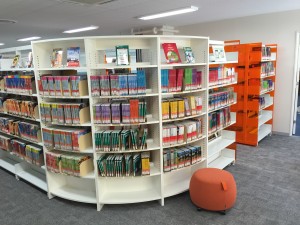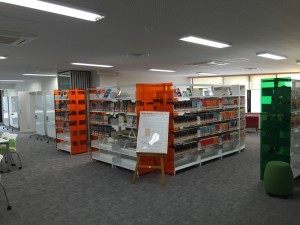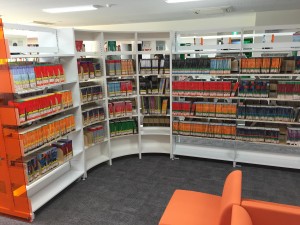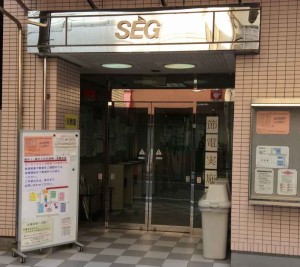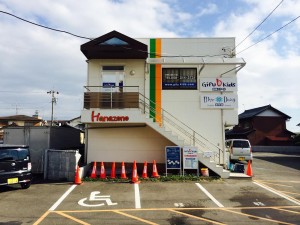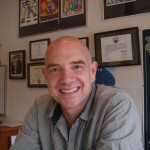The Tohoku University Library
The library just got a makeover, and you should see what they did with the Readers Corner
I am so grateful to the library staff for their support and encouragement. They’ve been on board with our reading program for the last five years, and I am so proud that I was able to contribute to this project.
This is the fifth iteration of the Readers Corner, which is the library’s collection of graded and leveled readers, and I think this is the best one yet. Classes start today, and the newly refurbished library opens for business for the first time.
The Readers Corner is surrounded by well-lit seating and study areas, making it easy to read books there (useful for students trying to power through the lowest level readers, which aren’t really worth borrowing as they can be read in 5-10 minutes).
The inside bookshelf, with higher level books.
This might be the best thing I have accomplished here at Tohoku University, providing the push to get this started. A great start to the second semester 🙂
The Tohoku University Library can be used by the general public after registering. Please come and check out our English materials if you are interested. Drop me a line, and I’ll be happy to show you around.
Exeunt Yoyogi
Just a short update today, from the UK. The demographic and societal changes in Japan are also affecting the private educational sector. Here’s an article explaining what’s happening to Yoyogi Seminar (hint: they’ll be closing their Sendai branch).
I wonder if this has any implications for English schools?
curriculum extensive reading language courses school management: Akio Furukawa English in Japan extensive listening extensive reading juku SEG yomiyasusa level
by sendaiben
5 comments
A Visit to SEG
The Best ER Program in the World?
A couple of months ago I finally had the chance to visit SEG in Tokyo. This is Akio Furukawa’s school, and one of the biggest ER programs in the world. I wrote an article about my observations and thoughts for the Extensive Reading SIG newsletter.
You can also read the full text of the article below:
I had wanted to visit SEG for years, so I was delighted when the opportunity to do so came up in March 2014. I am very grateful to Akio Furukawa for inviting me, and to all the teachers and students who welcomed me so warmly into their classes.
SEG (Scientific Education Group) is a juku located in the heart of Shinjuku in Tokyo. It is a successful business, serving around 3,000 students a year and helping many of them toward academic success. SEG was founded in 1980 teaching mathematics and science, but in 2000 started offering extensive reading classes. These were changed in 2006 into the current format of classes split between ER and oral communication. For extensive reading practitioners, SEG is important because of the activities of its founder, Akio Furukawa. Originally a mathematician, Mr Furukawa is perhaps best known for the YL (yomiyasusa level) readability scale and the extensive lists of word counts he publishes in the English ER Complete Book Guide, currently in its 4th edition, available online at SEG. Mr Furukawa has also been very active in promoting ER in Japan through his activities with the SSS (Start with Simple Stories) movement, JERA (the Japan Extensive Reading Association), and his numerous publications on ER.
First impressions
SEG is just a few minutes’ walk from Shinjuku station, just off the main street. The first hint that you might be drawing near is the various staff members wearing blue SEG armbands as they keep an eye on the students walking to and from the school. The school is actually spread out among a number of different buildings in its neighbourhood, each holding several floors’ worth of classrooms. The English classrooms are essentially mini-libraries, with each one holding around 20,000 books. The desks are standard Japanese school issue, with twenty to thirty per room.
Glancing at the shelves reveals an eclectic mix of graded readers, levelled readers, picture books, children’s books, young adult, and regular fiction and non-fiction. There are two types of classrooms: one for beginners consisting mainly of Oxford Reading Tree, picture books, and easier graded and levelled readers, and one for more advanced students with higher level books and novels. I saw several of my own favourite books at the school, including the Dune series, Heinlein’s Citizen of the Galaxy, the Millenium trilogy, Nick Sharratt’s Pants books, and pretty much all of the books I use with my students. I also managed to read a couple of new ones that I really enjoyed: The Giver by Louis Lowry and The Report Card by Andrew Clements. I was supposed to be observing the class, but the books proved too tempting. To be honest, I could have spent months there reading.
The second thing I noticed was how focused the students were: They all had books to read, or listen to on personal CD players, and were quietly getting on with things. Between books they would fill in their reading records and consult with the teacher.
The curriculum
SEG’s English curriculum is divided into two strands: extensive reading classes taught by Japanese teachers and communication classes taught by native speakers. The ER classes are conducted in Japanese and the communication classes are conducted in English. Classes contain up to about 15 students and are led by one teacher, occasionally assisted by trainee teachers.
The communication classes start out as speaking and listening for junior high school first-year students, and add intensive reading and writing later on. These classes use textbooks and are held in the English classroom-libraries described above. In the current SEG system, students stay in the same classroom for both ER and communication classes while their teachers switch halfway. Both classes run for 80 minutes in a three-hour block with a 20-minute break in the middle. During the extensive reading classes, students mainly read silently. There are supplementary activities such as listening, shadowing, and speed reading, but for much of the class there is a quiet hum of concentration. Each student reads at their own level, and can choose whether to read, listen, or listen while following along in their book. Most of the books I saw for lower-level students had CDs to accompany the text.
SEG teaches a purist approach to ER: students read without dictionaries and stop reading if they find books difficult or uninteresting. There are no tests or book reports to write: instead students make a record of the book title and write a short comment about it. Students record their reading in special notebooks, and many of the students I saw had incredible cumulative word counts, including one high school girl who was approaching 4 million words! Students were reading a range of books, from Oxford Reading Tree to compendiums of famous murder cases.
Discovery: Guided extensive reading
It was not actually until the morning of the second day that I realized the significance of what I was seeing in the SEG extensive reading classes. I had been distracted by the amazing libraries, the orderliness, and the student achievement. The real point of interest, however, is the teaching method. It does not say much for me that I had read about SEG, talked to teachers at SEG, and observed half a dozen classes, and still had not realized what was going on.
At SEG, students do not choose books. Instead the teachers, based on their knowledge of the students’ level, their interests, and the books, suggest books that they think are appropriate for the students to read next. This method is similar to what Donalyn Miller describes in her book The Book Whisperer. An experienced teacher can make better recommendations than students can choose for themselves, because they have actually read all the books and know which books have appealed to which students in the past. A skilled teacher can push students to read a little more, to read something a bit more difficult, or to take a break and read something easy if they are tired or low on energy.
Seeing this in action is impressive. Teachers flit around the classroom chatting with students as they finish reading, grabbing specific titles from the shelves in passing and dropping them in front of students. Occasionally the teacher will look at a student’s comments in their reading record, or pause to write something in their own notes. I talked to a couple of the teachers about this central aspect of their classes, and they confirmed that it was not as effortless as it looked. Teachers keep detailed records of what each student has read, including notes on whether they liked it, found it difficult, or gave up. They spend time before class mentally preparing and lining up possible books. One teacher I spoke to spends most of her 90-minute commute thinking about and making notes about which books to recommend to each student.
The students are not passive in this process, but are involved in a constant dialogue with their teachers, both through their reading notebooks and also by talking about each book as they finish it. Students are free to stop reading books if they find them boring or difficult, and often make requests or suggestions. One student in a class I observed asked his teacher for a book featuring water polo, a request that had both of us stumped! Teachers at SEG try to balance graded and non-graded material to maximise the benefit to students. While graded readers are often a better fit in terms of accessible language, levelled or native materials tend to be more attractive and interesting. A judicious mix of books allows students to get the best of both worlds.
The other key ingredient in the ER program is in-class reading (sustained silent reading), which means that the students do at least 70-80 minutes of reading in English a week. Many students also take books home with them, and of course starting them in class makes it much more likely that they will finish them as homework. Mr Furukawa told me that roughly a third of his students attain high proficiency in English (as measured by independent test scores). As a point of reference, I would say that maybe 10% of mine go on to master English and make it a part of who they are.
Conclusion: Lessons to take away
My visit to SEG blew me away. The size and success of the school, the richness of the resources, the achievement of the students, and the skill and knowledge of the teachers changed my view of what is possible. I don’t think I will be able to adopt guided extensive reading in my university classes. With over 40 students per class, I just won’t be able to give each student enough attention, but I can certainly try to increase the number of interactions I have with students. I have resolved to contribute more to students’ reading choices by recommending books and giving advice. Mr Furukawa and SEG welcome visits from teachers, and I recommend that any teacher interested in extensive reading or English teaching consider giving them a visit.
GUEST POST: Do Or Die
Securing your future in EFL
Today I am extremely pleased to feature a guest post from Mark Kulek, a school owner from Gifu. Mark is a great guy, a passionate educator, and, as you’ll see from his post below, a shrewd business owner.
First, let me thank Ben for this opportunity to share my experience with his readers.
Ben published a post that concerns me and many others who are teaching English conversation here in Japan.
Ben asked me to share what I am doing to survive in the English conversation business.
Background information:
I arrived to Japan in August of 1996 with no experience teaching English or running a business. I graduated with a degree in literature, but had no plans of teaching at that time. After graduating from my university, I worked as a sales representative. I liked it, but never really felt satisfied.
My sister left for Japan in 1992. I felt a little jealous of her. She was off to a fantastic adventure and I was still doing the same old thing. When she had come back home, she told me that I would love it in Japan. She planted a large seed in my head.
I came to Japan with one main goal, to make money.
In 1996, my group of friends were all hustling to earn money. We all had our full-time job, but that was not enough. We took on private students, part-time work and even performed as priests doing wedding ceremonies. Very early upon my arrival I knew that I could work hard and have a comfortable life. And I knew that I could make it on my own.
In 2001, I opened a conversation school. At first, I was only open a few days a week supplementing my income with part-time work. After a few years, I was busy five days a week plus I needed a part-time teacher. This situation continued. Then about four years ago things changed.
Demographics started impacting enrollment. My area was graying quite fast. Young families were not moving into my area. The local kindergarten was losing students. Two local elementary schools had to merged. From 2011, basically, I had zero new enrollments at the school. The future was looking bleak.
In the meantime, I was working at a few kindergartens part-time. One particularly valued English learning more than the others. This is the kindergarten that changed everything for me. I worked there once a week doing kanai classes. Once a week turned into twice a week plus I did after school kagai classes.
I had to make a change.
The kindergarten’s owner had a building, not being used, right next to the kindergarten. Each week I would look at that building and think, “this would be an ideal location for my English school.”
I took the principle/owner of the kindergarten out for dinner. We had a few glasses of beer, enough to get us feeling happy. I then suggested that we go into the English conversation business together. He was very positive about the prospect, but needed some time to think about it. He did and we formed a partnership. We fixed up that old building and made it the finest English conversation school in the city.
I am happy to report that our partnership is working out beautifully.
I moved into the new facility in September of 2013. 50 students from the previous location relocated with me. From September 2013 to March 2014, 22 new students have joined. From April 2014 to May13, 2014, 46 new students have joined. There are trial lessons scheduled through June. I predict that we will have new students joining throughout the academic year.
In conclusion
It’s win win for both of us. The kindergarten is providing more services, convenience, safety and personalization to their students. As for me, I’m getting job security, business help from people who have been running a kindergarten for over 50 years and financial backing. One of my biggest concerns (before the partnership) was one day being able to step back from day-to-day teaching, after all I am not getting any younger.
This partnership with the kindergarten will allow me to run a successful business. In fact, since September 2013, I have hired two part-time teachers to cover the increase of students. This has allowed me to focus on management, to help my teachers, and to make materials.
I feel I have set myself up for a long and prosperous future in the English conversation field.
I make my home in Gifu, Japan, where I have an English conversation school for both adults and young learners. I have been teaching EFL for 18 years. I’m interested in professional development and activity-based curriculums. You can find me on Twitter as @gifumark
curriculum eikaiwa expectations language courses school management university
by sendaiben
2 comments
Kaizen, the art of gradual improvement
An essential part of program development
I mentioned kaizen (continuous improvement) at the end of my talk on ER program design.
Kaizen is making things better, continuously. Basically finding and solving problems over and over again. Over time, this results in huge improvements and the evolution of programs.
I’ve been very fortunate to be able to work with my colleague Dan E at Tohoku University, who is a master of kaizen. Thanks to this, our extensive reading program is several orders of magnitude better than it was when we started collaborating.
At Cambridge English as well, thinking back to when we started over ten years ago the school and the classes are unrecognizable. Almost everything we do, we do better now.
But kaizen does not happen automatically. It requires teachers to have the desire and the ability to make changes. It also requires a culture of development, where problems lead to solutions that are implemented across the board. Communication is essential and talking about problems with colleagues leads to better solutions.
Some examples of kaizen at Tohoku University:
- improving worksheets so that students understand them better
- developing bilingual explanations
- sharing effective class activities
- developing protocols to deal with cheating
- having students write book reports in class instead of for homework
Examples of kaizen at Cambridge English:
- developing electronic and paper record keeping
- writing student names in romaji on everything (books, notebooks, attendance cards)
- developing lesson plans
- choosing materials
- organizing the classroom
As you can see, nothing groundbreaking. The main point is that improvements are continuous, problems are dealt with as they come up, solutions are reached through communicating with colleagues and are implemented by everyone.
Kaizen is barely noticeable in the short term, but over a longer period the improvements are staggering.
Do you have any positive or negative experiences with kaizen?
